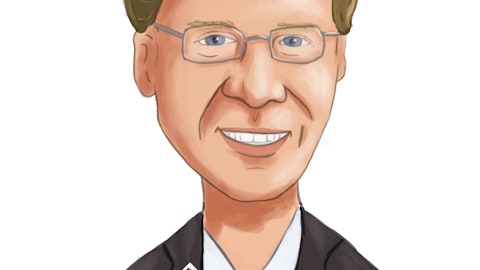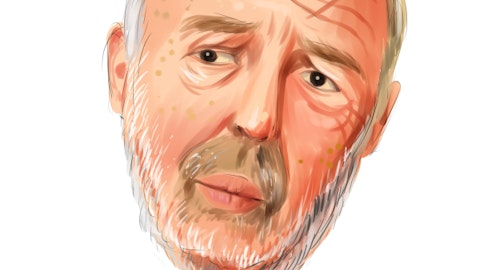Telefônica Brasil S.A. (NYSE:VIV) Q3 2023 Earnings Call Transcript November 1, 2023
Operator: Good morning, ladies and gentlemen. Welcome to Vivo Third Quarter 2023 Earnings Call. This conference is being recorded and the replay will be available at the company’s website at ri.telefonica.com.br. The presentation will also be available for download. This call is also available in Portuguese. To access, you can press the Globe icon located on the lower right side of your Zoom screen and then choose to enter the Portuguese room. [Operator Instructions] [Foreign Language] Before proceeding, we would like to clarify that any statements that may be made during this conference call regarding the company’s business prospects, operational and financial projections and goals are the beliefs and assumptions of Vivo’s executive board and the current information available to the company.
These statements may involve risks and uncertainties as they relate to future events and therefore depends on circumstances that may or may not occur. Investors should be aware of events related to the macroeconomic scenario, the industry and other factors that could cause results to differ materially from those expressed in the respective forward-looking statements. Present at this conference, we have Mr. Christian Gebara, CEO of the company; Mr. David Melcon, CFO and Investor Relations Officer; and Mr. João Pedro Carneiro, IR Director. Now, I’ll turn the conference over to Mr. João Pedro Carneiro, Investor Relations Director of Vivo. Please Mr. Carneiro, you may begin the conference.

A long-distance telecommunications tower looming large against a dawn sky.
João Pedro Carneiro: Good morning, everyone. Welcome to Vivo’s third quarter 2023 earnings call. The presentation will be divided in two parts. First, our CEO, Christian Gebara, will walk us through Vivo’s financial and operating highlights, followed by an update on our new sources of revenue and ESG advances. Then our CFO, David Melcon, will comment on our financial performance and shareholder remuneration in more detail. I now hand the call over to Christian.
Christian Gebara: Thank you, João. Good morning, everyone. Appreciate you joining us. I’ll start by presenting the highlights of another very strong quarterly result. We delivered a revenue growth of 7.5% year-over-year and an EBITDA increase of 11.7% year-over-year, both well above inflation. The customer base mix keeps improving. Postpaid access surpassed the mark of 60 million customers and homes connected with FTTH summed up six million access. Our high value subscriber base is fueling our growth engine. This growth was combined with improved profitability, EBITDA was at an all-time high, reaching R$5.5 billion in the quarter with a margin of 42.2%, leading to improved bottom line performance as net income reached R$3.4 billion year-to-date, up 15.9% year-over-year.
As we continue to reduce our CapEx intensity to meet the level guided for the year of up to R$9 billion, cash flow generation speeds up. Over the first nine months of 2023, our operating cash flow grew 27.1% year-over-year to R$8.9, billion while our free cash flow expanded 16.7% to R$7.6 billion. As such, we are committed to keep an attractive level of shareholder remuneration. Up to October 2023, we already declared R$2.6 billion in dividends and interest on capital while also invested R$380 million to buy-back our own shares. Moving to Slide 4, we show the breakdown of our revenue growth. Our focus on best-in-class technologies contributed to total revenue growing 7.5% year-over-year, well above inflation. On the mobile side, the continuous upselling to postpaid plans coupled with pricing rationality, allowed mobile service revenues to reach an organic expansion of 9.0% year-over-year in the second comparable quarter since the acquisition of part of Oi Móvel’s assets.
Handsets and electronics posted a 13.5% annual increase as we outpaced the market in the selling of high value 5G devices and offer a broader portfolio of electronics. FTTH and corporate data, ICT and digital services continue to grow double digit, meeting the demand for high quality connectivity and digital services. These services are the drivers for the positive expansion of our fixed revenues. Turning to Slide 5, we can see the improvement of our mix of customers as postpaid already represents 62% of total mobile access. Our mobile leadership has been reinforced as we continue to deliver an unmatched value proposition to our customers. This strong operational momentum, combined with our pricing strategy resulted in an 11% annual growth in ARPU, reaching its highest value in the last three years.
While average spend increases, postpaid churn has reduced 39% in the last four years, reaching a very low level of 1.09% per month. With customers staying longer and spending more with us, we see a clear pathway to deliver sustainable real growth on a consistent base. On Slide 6, we detail the advance of our top-notch fiber operation. Vivo’s fiber footprint is present in 439 cities throughout the country, totaling 25.1 million homes passed, which keeps up on track to reach the target of 29 million homes passed by the end of next year. In the last 12 months, we added 2.8 million fiber-to-the-home premises and connected, 715,000 homes, increasing our network take-up rate after reaching six million users while also improving our ARPU profile.
In addition, Vivo Total, fiber and mobile convergent offer surpassed the mark of one million customers, more than doubling its base over the last 12 months. This offer has the lowest churn and the highest lifetime value, putting Vivo in a unique position to benefit from convergence in the long term. Going to Slide 7, you can see that the digital B2B services added up to R$3.2 billion in the last 12 months, up 28% year-over-year, already representing 6% of Vivo’s total revenue, even though these services are currently provided by Vivo to only around 10% of our 1.5 million B2B customers. Going forward, we see a significant opportunity to increase the penetration of digital solutions in our existing B2B customer base, mainly in SMEs. With that in mind, Vivo Meu Negócio has a new position and focus on integrated digital solutions for micro, small and medium enterprises tailored by size and sector.
We offer accessible products related to cloud, sales management, web presence and efficient tools to help these entrepreneurs adapt their business to compete and prosper. Moving to Slide 8, we give an update on the evolution of some of our new sources of revenue in the B2C segment. Financial services generated R$106 million in revenues during the quarter, up 45% year-over-year. Here we highlight Vivo Money that ended the quarter with a portfolio of R$307 million in personal loans more than doubling year-over-year. In the end of July, we announced that Vivo Money has a new investor Polígono that has committed to invest up to R$250 million over the next two years to strength the expansion of our credit services. The distribution of video and music OTTs through our invoice totaled R$144 million of revenues in the quarter up 33% year-over-year coming from 2.8 million OTT subscribers.
Our partnership with the main content providers allows us to expand average customer spend, decrease churn and increase lifetime value. More recently, we broadened our electronics portfolio that includes notebooks, smartphone accessories, smart home devices among others to complement experience provided through our connectivity services. This product generated R$79 million in revenues last quarter up 28% year-over-year. We know that revenues from financial services, OTTs and electronics beyond smartphones put together represented 3% of Vivo’s total revenues over the last 12 months. As they keep this strong growth pace, we are confident that these new businesses will have a greater relevance over the next years. On Slide 9, we highlight some advances in environmental and social fronts.
We have a target to achieve net zero emissions by 2040 and to help us reach this goal we establish a program with 125 carbon-intensive suppliers to diagnose, train and encourage these partners to move towards this commitment. On energy, Vivo is the first company in the sector operating in energy self-production modality. We announced a partnership with Elera in the State of Minas Gerais that comprises four solar parks. Lastly, I’m glad to share two important recognitions. First, Vivo is the only telco and Brazilian company in Fortune’s Change the World list due to the Vivo’s Recicle program, our main initiative in circular economy. We were also highlighted once again in the Great Place to Work ranking being one of the top 10 best companies to work in Brazil.
Now David will walk us through our financial performance.
David Melcon: Thank you, Christian, and good morning, everyone. On Slide 10, we show the results of our commitment to an efficient cost structure. Total cost was up 4.6% year-over-year well below our revenue growth. Cost of services and goods sold increased 5.9% year-over-year as revenue from B2B digital solutions, handsets and electronic increased. Cost of operation, which represents 67% of total OpEx, was up 3.9% year-over-year accelerating versus previous quarters and below inflation in the period. The performance is explained by the acceleration of commercial activities, continuous efficiency and digital initiatives, bad debt improvements and a positive net effect of R$175 million on matter related to the Oi Móvel acquisition.
Moving to Slide 11, our focus on top tier technologies such as 5G and fiber is contributing to a better mix of capital spent. In the first nine months this year, we invested R$6.7 billion, a decrease of 5.3% year-over-year, representing a CapEx to sales ratio of 17.3%, on track to reach our guidance of CapEx below R$9 billion this year. As a consequence of a very strong operating performance coupled with controlled investments, our operating cash flow sum up an impressive value of R$8.9 billion year-to-date, up 27.1%. We are optimistic about the opportunities to further reduce our capital intensity going forward. On mobile, we already covered more than 40% of the population with 5G, while on fiber, a significant part of the home pass footprint we plan to have, have already been deployed.
On Slide 12, you can see that our profitability metrics keep on improving as a result of a very positive operating momentum and solid financial execution. As such, net income and free cash flow increased every quarter of the year on an annual basis, reaching in the first nine months this year, R$3.4 billion and R$7.6 billion respectively, growing at double digit rates year-over-year. This also resulted in a low debt level. Financial net debt decreased 76% year-over-year. Even considering IFRS 16 leases leverage remains well controlled at 0.6x EBITDA. All these figures allowed us to keep investing in our growing businesses and maintain attractive shareholder remuneration. Lastly, on Slide 13, we update you on our capital reduction request to Anatel.
In September this year, we had a positive outcome as Anatel granted a prior consent to reduce our capital stock in up to R$5 billion in one or more events. With this approval, we have more flexibility to decide the best mix of shareholder remuneration for the next years through the combination of capital reduction, dividends, interest on capital and share buybacks. 2023 shareholder payments sum up R$4.6 billion year-to-date, including our share buyback program. Our priority is to continue delivering a unique combination of growth, profitability and return to shareholders. Thank you. And now we can move to the Q&A.
See also 11 Best Military Drone Stocks To Invest In and 16 Biggest Lab Grown Meat Companies in 2023.
Q&A Session
Follow Vivo Participacoes S A (NYSE:VIV)
Follow Vivo Participacoes S A (NYSE:VIV)
Receive real-time insider trading and news alerts
Operator: [Operator Instructions] Our first question comes from Fredi Mendes from Bank of America. Please, Mr. Fredi, your microphone’s open.
Fredi Mendes: Hello. Good morning, everyone and thanks for the call. I have two questions here. The first one, it is on CapEx. You already mentioned a few times on the presentation that you keep below R$9 billion for the year. But historically the fourth Q is the strongest, the highest in terms of cap. Just double checking because if we use the same numbers for the third Q, you’ll be slightly above R$9 billion. So just want to double check that. And how are you seeing this number for 2024? In our calculation here, there is room for some decrease year-over-year in terms of CapEx. But obviously I would like – be great to hear your view on that. And the second point on mobile. I’m assuming also you’re already doing the budget for 2024 and obviously the macro scenario can always change.
But with the information we have today, do you think there is room for us to continue to see this real increase in terms of price or that’s something that happened in 2023 more like a one-off and should not happen in 2024 as well? Thank you very much.
Christian Gebara: Hi, Fred. This is Christian. So, going to your questions on CapEx. Yes, we kept what we said. No, we’re going to be up to R$9 billion this year for CapEx. There is a decisionality of the CapEx, but that’s confirmed the target that we have for the year. Regarding 2024, we are not giving guidance right now. What I said in the past is that last year was the peak that we had in CapEx because of the Oi integration and part of the 5G auction. There are some parts of the obligation that we had to invest. This year as we said in the beginning of the year, it was going to be a more reasonable CapEx up to R$9 million. Next year we’re not going to see any peak. So I don’t give guidance now, but I think it’s continued to keep the trend.
Regarding the revenues, yes, as you said, no, there is – also not giving guidance for revenues. What we see here now that we presented in this call is that we’ve been very successful attracting customers, both mobile and fiber customers. So net adds being very strong, churn is very controlled, actually easing the lowest level in the mobile and in the fixed, if you consider Vivo total that we have more than 1 million customers to date, we are talking about a churn that is lower than 0.5% per month. We’ve been very successful in adding new services to our services in both mobile and the fix. So you see the ARPU evolution. That is also a good sign of our strategy of adding more services or migrating upselling customers within the same segment that they are.
So combining all of this, I don’t see any operational or competitive in our case, the value proposition that we offer to be different in the next months. So, confident about the future, but not giving you a specific guidance.
Fredi Mendes: Perfect, Christian. Very, very clear. Thank you very much.
Christian Gebara: Thank you, Fred.
David Melcon: Thank you.
Operator: Our next question comes from Bernardo Guttman from XPI. Please, Mr. Bernardo, your microphone’s open.
Bernardo Guttman: Hi. Good morning, everyone. Thanks for taking my question. Actually, I have two here from my side. The first one, when considering margin dynamics, you are experiencing a consistent growth trend. There seems to be significant potential in leveraging the Oi customer base for digitalization and also upselling opportunities. However, it would be available to understand that the sustainability of this margin increase for the next year, also considering the fixed part of the business. And the second question is regarding basically asking for an update on the network sharing agreement with TIM and if there is any discussion to expand the scope for 5G? Thank you.
Christian Gebara: So Bernardo, I will start and then David may continue if he wants in the margin, then I come back to discuss the TIM. Look, we are growing EBITDA in a very solid way. So, as we have been discussing with you in the past, we are growing inflation and EBITDA – sorry, revenues and EBITDA above inflation. And that’s a very positive sign. Actually revenue is growing in all lines. We are growing in mobile, we are growing in, what we call, smartphones and electronics and we are growing the fixed. Now, in the fix, if you take out what is – what we call, non-core, that is voice and DSL, our growth would be a double digit. So positive growth. Part of this growth is also in digital services. I think I highlighted here 6% of our revenues already in B2B digital services.
And we can calculate on average here 3% may be in digital services in B2C. So our mix of revenues is changing. Some of the services, they have a different margin, but they have no CapEx. So if you consider the operating cash flow margin that we are presenting here or even their free cash flow margin that we are presenting in the nine months, you can see a significant increase in these two margins. So our objective here is to continue to grow absolute numbers, revenues, EBITDA and improving the margins that we present both in operating cash flow and in the free cash flow considering the new mix of products that we are selling that I just described here a summary of them. Having said that, of course, there is a lot of initiatives in reducing costs.
We are driving the company to digital – as digital interaction with our customers. That has an impact in customer care, but also has a strong impact in commissions and many other commercial OpEx that we have then going to be reduced when you drive it even more digital. So, here’s a combination of factors. Obsession here is to increase in absolute numbers and obsession here is to have operating cash flow and free cash flow margin much stronger.
David Melcon: Yes. Let me also add, Bernardo, the question about Oi. So we have the synergies as we say, we acquired Oi 18 months ago. We say that we’re going to have a synergy from OpEx and CapEx of R$5.4 billion equivalent to the amount we paid. And this is coming nicely every quarter. That’s why you are seeing, as Christian say, an operating cash flow growth in the quarter of 22.9% and in the first nine months we are growing operating cash flow in 27.1%. So this is the line that we are looking at and particularly we are monitoring and we are tracking in absolute numbers.
Christian Gebara: Can I go to the rent sharing, Bernardo, or any other question?
Bernardo Guttman: Yes, please. Thank you. Thank you. Very clear, the first one. Thank you.
Christian Gebara: Okay. So here we have like we are very keen on this initiative for rent sharing with team. Here we have three dimensions of this initiative. The first one was expand 4G coverage. So that happened in 716 cities, approximately 360 cities to each of the operators that was successfully implemented. So cities that team had presence and we didn’t or in the opposite, so we could do that and that was great. And we may envision doing more in the near future, especially now that apart from 4G, we may have also the 5G deployment. Then there was a single grid model. That is what the first trench of this rent sharing was focused in cities of less than 30K inhabitants. Here we had a plan to do more than what we did so far at the end of this quarter.



